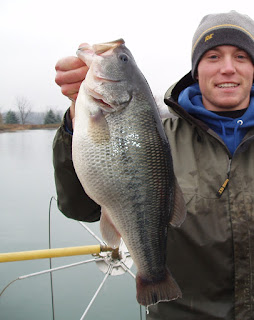By Dave Beasley, Lead Fisheries Biologist
Maintaining a fishery is both
challenging and fun. The standard
requirements are suitable habitat, proper fish species and balanced predator to
prey ratios.
Water quality is a given. Just like
humans do not do well in poor air quality, fish do not do well in poor water
quality. So if your pond does not have an
ample clean water source, you most likely to need to aerate. A simple water test will take the guess work
out of the equation. If aeration is implemented,
not only will the fish benefit, but the whole ecosystem will as well.
With an environment fit for fish,
having the proper species is a must. The
size of the pond along with water temperatures throughout the year will have a
direct impact on what fish should reside in the pond. Fish species have different life cycles that
need to match the pond’s environment. Many
fish are very picky, relying greatly on proper water temperature and the ideal
environment in order to successfully reproduce.
Once the fish species of choice
inhabit the pond, they need to be managed.
Naturally the predator fish will feed on the smaller fish, reproduce,
and over time overpopulate, forcing the pond out of balance. Without an ample population of baitfish the
predator fish will not grow, and as a result predators become stunted and
skinny. This common problem can be
corrected, but is best if prevented.
Professionals have the tools and knowledge to keep ponds from getting
out of balance.
Supplemental feeding is a great
option. Most fish species can be trained
to eat pelleted feed. Feeding predator
fish artificial feed will relieve pressure on the bait fish; this in turn keeps
the pond from getting out of balance as quickly. The baitfish will also eat the artificial
feed, creating healthier bait with better reproduction rates and better
survival rates. As an added benefit of
feeding, the pond will be able to support far more fish.
Whether you feed your pond or not, the
fish population will still become predator heavy. One tool used to remove over populated fish
is an electro-shocking research vessel. Using
this type of vessel, excess fish can easily be removed from a pond. The electro-shocking research vessel’s
primary use is to assess fish populations.
Using Direct Current produced on board, the fish are stunned in a safe,
harmless manor. The fish are then
brought onboard using dip nets and placed into a holding tank. While aboard, the quantity of each species is
recorded along with their length and weight.
Using the data to determine the pond’s relative abundance and relative
biomass we are able to make accurate management decisions.
With the fish populations in check,
the habitat within the pond needs to be maintained. A pond consisting of 15% vegetation is good
for a healthy fishery. Fish use plants
as a source of cover when avoiding predation.
Other fish use the vegetation to hide when preying on fish. Some species of fish even lay eggs on plants
when spawning. Unfortunately many plants
have the tendency (just like predator fish) to take over the pond. Using Grass Carp and/or aquatic herbicides,
vegetation can be controlled and maintained as desired. If taking part in a fertilizing program you
should eradicate most species of vegetation prior to fertilizing.
Creating and maintaining a fishery
can be a great deal of fun and a rewarding process. The benefits will be quality fishing time
with your family and friends.
Dave Beasley
is a Fisheries Biologist with SOLitude Lake Management. Serving VA SOLitude Lake

No comments:
Post a Comment